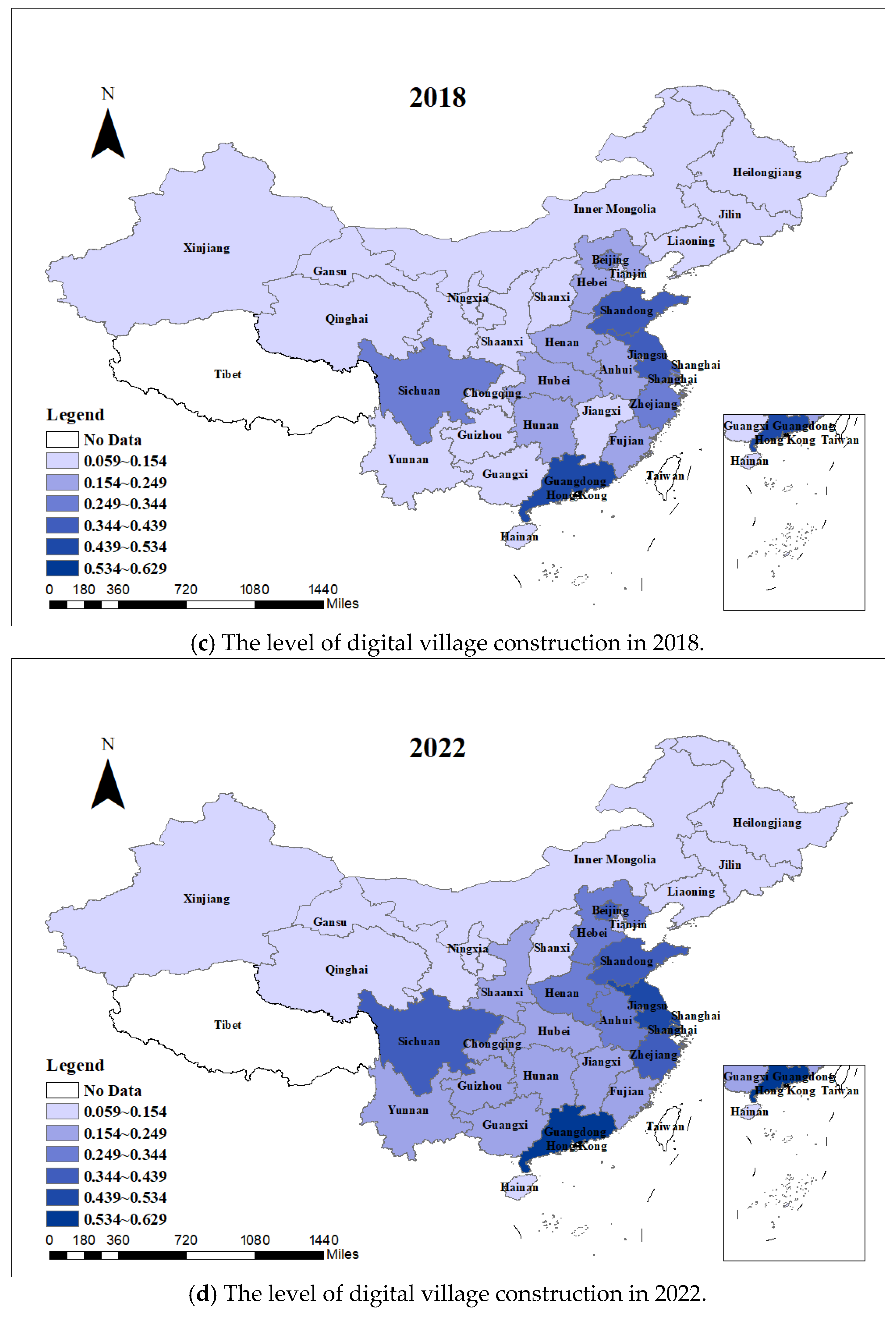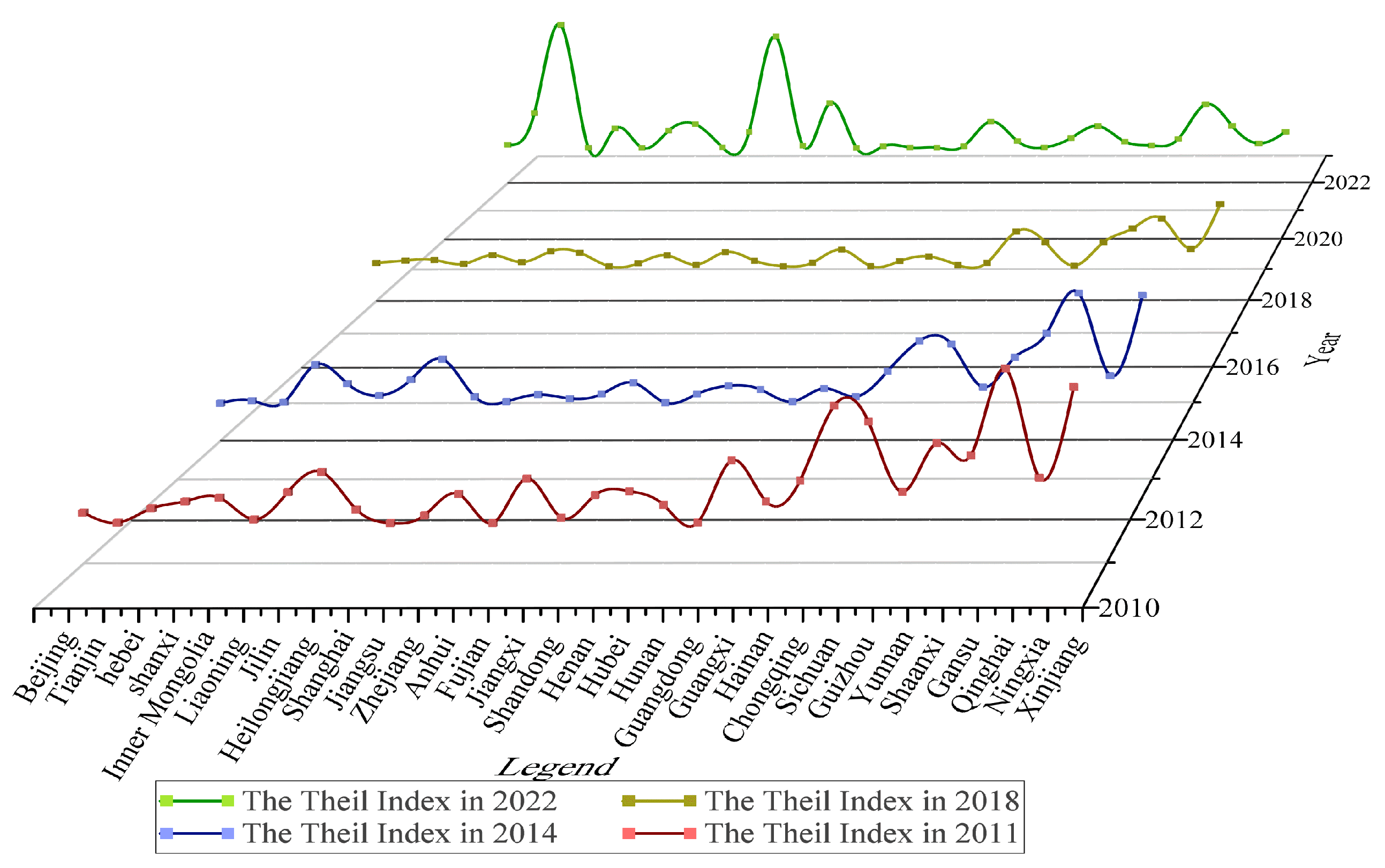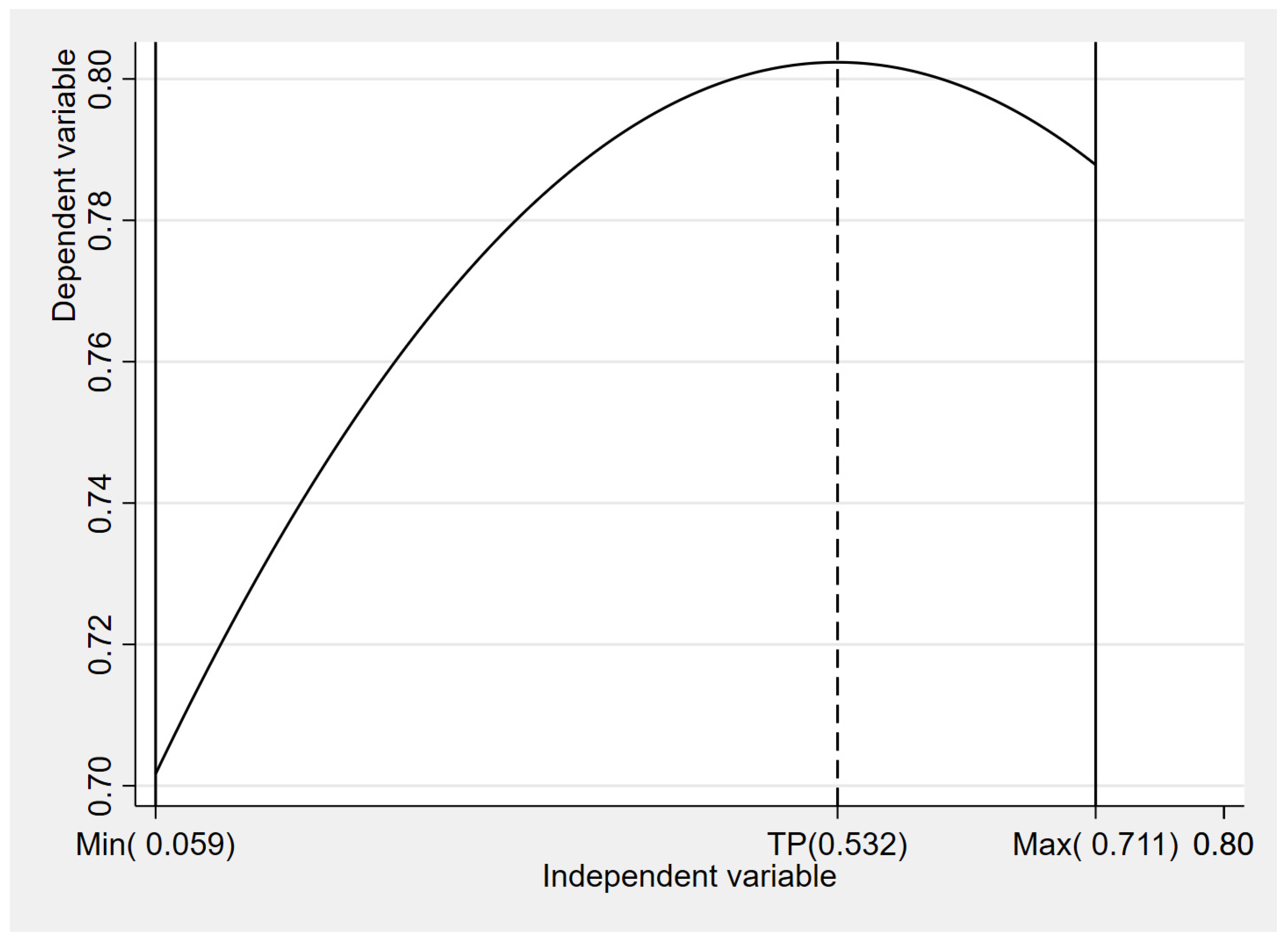1. Introduction
Energy is an important cornerstone for the development of social and economic activities, but the carbon emissions generated during its consumption process are the main cause of global climate change. According to the statistics and analysis of the International Energy Agency (IEA), over 90% of global energy-related carbon emissions come from the combustion of fossil fuels. The development, supply, and consumption of clean energy have become key links in coordinating economic growth with ecological protection. Clean energy has significant environmental advantages throughout its life cycle, with significantly lower carbon emissions; significantly reduced negative impacts on the atmosphere, water, soil, and other environmental elements; and a lower potential for threats to human health [
1]. As a result, more and more countries have taken the renewable energy transition as a strategic choice to address climate change and improve environmental quality [
2], and are actively promoting the transition from traditional to clean and low-carbon energy sources in order to achieve synergistic development of the economy, society, and the environment [
3].
The significance of energy consumption equality has been widely recognized by the academic community. The theory of equality of feasible capacity points out that the essence of the inequality in access to energy is the deprivation of the right to development. Some scholars have pointed out that the uneven distribution of energy resources has particularly led some countries to fall into energy poverty [
4]. Although there have been advancements in energy technology in developing countries, energy poverty remains prominent [
5]. Some scholars have also confirmed through cross-border research that for every 10% expansion of the energy consumption gap between urban and rural areas, the rural poverty rate will increase by 3.2% [
6]. The seventh United Nations Sustainable Development Goal (SDGs), “affordable and clean energy”, lists energy accessibility and equity as core indicators, emphasizing “ensuring that everyone has access to affordable, reliable and sustainable modern energy”, increasing the proportion of renewable energy in the energy structure can reduce energy poverty in countries where energy poverty is widespread [
7]. Thus, a few scholars have begun to focus on the relationship between the development of digital technology in rural areas and the consumption of clean energy [
8], and some scholars have focused their research samples from Norway on the “coordination between smart cities and rural areas” in developed countries [
9], but have not extended it to the context of developing countries. Some scholars have also found that the insufficiency of clean energy infrastructure in rural areas, such as India, has led to rural households’ reliance on traditional energy sources being much higher than that in urban areas [
10]. These studies lack large-scale panel data evidence for large developing countries such as China and Indonesia. In emerging economies in Asia and low-income developing countries in Africa and Latin America, the digital development in rural areas is slow, and the gap in clean energy consumption between urban and rural areas is the largest [
11].
In China, the proportion of clean energy consumption, such as natural gas and electricity, in urban areas is 57.3%, while in rural areas it is only 28.6%. Moreover, the proportion of traditional non-clean energy, such as biomass energy, in rural areas remains as high as 41.2%, the inequality in clean energy consumption (CEI) between towns and rural areas still exists [
12,
13], mainly reflected in aspects such as infrastructure, energy accessibility, and the utilization of clean energy [
14]. Specifically manifested in the differences in access to clean energy [
15], especially with the rapid economic growth in cities, which leads to higher investment in clean energy facilities than in rural areas. There are differences in the quality of clean energy consumption and service levels [
16]; 25.6% of people cannot afford basic energy services [
17], while natural gas and direct electric heating are unaffordable for low-income rural families [
18]. Under the promotion of the rural revitalization project and the towns–rural integration strategy, the “going to the countryside” of rural renewable energy has been significant [
19], and the clean energy business forms in rural areas have become more diverse. The integration of digital technology and rural development offers new possibilities for resolving this contradiction. Data from China’s Ministry of Industry and Information Technology show that in 2022, the Internet penetration rate in rural areas reached 61.5%, cumulative investment in digital village construction exceeded CNY 500 billion, and smart energy platforms covered 83% of administrative villages across the country. Has this infiltration reshaped the energy consumption pattern of clean energy in urban and rural areas? What characteristics does its influence mechanism present? It has become a realistic proposition that urgently needs to be answered.
This article provides three outstanding contributions. Firstly, incorporate China’s digital villages (DV) and the equality of clean energy between urban and rural areas into a unified research framework. Nowadays, many researchers at home and abroad have been discussing the socio-economic significance of rural digitalization and how rural digitalization affects rural economic growth [
20,
21] and how to implement China’s targeted poverty alleviation policy [
22,
23]. The research was also conducted on how to promote towns–rural integration [
24,
25], that is, digital villages bring economic, governance, or industrial effects to the development of rural areas in China. A small number of studies have focused on the achievements of digital village construction projects related to energy [
22], and some scholars have quantified the poverty alleviation performance of energy-targeted poverty alleviation infrastructure projects [
26,
27]. There is a serious lack of attention to the core dimension of social equity, namely, the equality of energy consumption, especially the equality of clean energy consumption. This article places greater emphasis on the significance of the impact of DV construction on the inequality in clean energy consumption between urban and rural areas, and is committed to assisting the government in formulating effective social and energy policies to alleviate this inequality.
Secondly, this study explores the transmission mechanism of digital villages on clean energy fairness. Promoting sustainable development and the energy revolution has always been a research focus in the academic community. Some scholars have found that the development of DV has a particularly significant impact on the agricultural sector [
28]. It promotes the digitalization of agriculture, helping farmers enhance their industrial development and technical levels. Other scholars have focused on the potential impact of information technology advancements on alleviating energy poverty; the innovation and application of digital village technology have opened up new paths for addressing issues such as unequal energy access [
29,
30]. However, it did not investigate how rural development gradually alleviates the inequality in clean energy consumption. This study emphasizes the mediating mechanism of agricultural technological progress (ATP) and industrial structure upgrading (IND) in the construction of DV, and the unequal relationship of clean energy between towns and rural areas.
Thirdly, considering the differences in towns’ social and economic development, geographical limitations of clean energy, resource endowments, and national policy pilots, this paper explores the effect of digital village construction in alleviating clean energy consumption inequality between towns and rural areas under different influencing factors. Empirical studies by other scholars mostly adopt cross-sectional data at the county or household level. There is a problem of limited sample range, making it difficult to reflect regional differences. By disentangling the spatial heterogeneity in how DV development influences towns–rural energy consumption inequities, this study reveals regional differences and provides suggestions for precise government decision-making.
5. Conclusions and Policy Recommendations
5.1. Conclusions
The study focuses on the influence of digital village construction on the CEI between towns and rural areas. Through an in-depth analysis of DV data to evaluate CEI in China from 2011 to 2022 using methods such as the bidirectional fixed model, this paper also undertakes an investigation into a robustness check to ensure the reliability of the benchmark results obtained.
The research results of this paper demonstrate that: Firstly, A statistically significant inverted U-shaped relationship exists between DV development and towns–rural CEI. During the early construction phases, DV initiatives may inadvertently exacerbate clean energy consumption disparities as town areas rapidly adopt advanced technologies while rural regions face infrastructure and adoption lags. However, upon reaching a certain stage of construction, it is anticipated that the project will assume a pivotal role in addressing the disparity in clean energy consumption between towns and rural regions. Secondly, it is evident that ATP and IND play a pivotal mediating role in the relationship between the construction of DV and the CEI between towns and rural areas. The establishment of DV has been demonstrated to encourage technological advancement within the agricultural sector, facilitate the transition of agricultural production to clean energy sources, and enhance the self-sufficiency capacity of rural energy systems. Concurrently, it will drive the upgrading of the industrial structure, optimize the energy consumption structure in rural areas, and increase the demand for clean energy. Thirdly, under differing social and economic development conditions, topography and landforms, degrees of energy transition, and government policies, the impact of digital village construction on the CEI between towns and rural areas varies. In regions exhibiting a lower level of urbanization, elevated terrain undulation, non-clean energy demonstration provinces, and varying degrees of the energy transition, the effect of digital village construction in alleviating the CEI between towns and rural areas is more significant.
5.2. Policy Recommendations
Based on the above research conclusions, we propose the following policy suggestions.
Firstly, efforts must be made to ensure the equitable advancement of digital technologies within the domain of rural construction. On the one hand, the government should increase investment in the construction of digital infrastructure in the central and western regions, areas with lower urbanization levels, and rural areas. It should support the construction of 5G base stations, fiber-optic networks, smart grids, and other infrastructure in rural areas, enhance the application capacity of digital technology in rural areas, and narrow the gap in digital village construction among regions. Conversely, the promotion of social capital participation in the construction of DV, the application of digital technology in agricultural production and other fields, the enhancement of agricultural production efficiency and farmers’ income levels, the ensuring of the benefits of digital village construction to all rural residents more widely and evenly, and the promotion of the fairness of clean energy consumption in towns and rural areas are recommended.
Secondly, the coordinated development of ATP and IND should be promoted. It is imperative to encourage digital technology to drive ATP. Furthermore, there is a need to develop and promote green and energy-saving agricultural technologies and equipment suitable for rural areas. In addition, the provision of purchase subsidies and technical guidance for intelligent irrigation systems, solar agricultural equipment, etc., is essential, as is the improvement of the efficiency of clean energy utilization in agricultural production. Conversely, efforts must be made to guide the optimization and upgrading of the rural industrial structure, cultivate and develop the third emerging industries such as digital agriculture, rural e-commerce, and digital rural cultural tourism, promote the development of rural industries towards low energy consumption and high added value, further boost the growth of clean energy consumption in rural areas, and alleviate the CEI between towns and rural areas.
Thirdly, the policy design for clean energy demonstration provinces should be optimized. In the case of provinces that have been designated for the demonstration of clean energy, it is imperative that the policy orientation is adapted, placing particular emphasis on the coordinated development of both towns and rural regions. It is imperative to give full consideration to the actual needs and development characteristics of rural areas in order to circumvent the so-called “Matthew effect”. Conversely, there is a necessity to pursue the augmentation of investment and the endorsement of rural clean energy initiatives. Furthermore, the promotion of the digital transformation of rural energy networks is imperative, as is the narrowing of the so-called “digital divide” between towns and rural regions. It is imperative to ensure that the construction of DV in the demonstration province can effectively alleviate CEI between towns and rural areas.
Fourthly, efforts must be made to consolidate the construction of the clean energy supply system. In the context of diverse energy transition regions, the formulation of distinct clean energy development strategies is imperative, with these strategies being informed by local resource endowments and energy supply characteristics. In contrast, regions characterized by a high energy transition should focus on the optimization of smart grids, with the objective of enhancing the efficiency of clean energy transmission and distribution. Conversely, regions experiencing a low energy transition should prioritize augmenting support for the development and utilization of clean energy sources, while concomitantly reducing their reliance on fossil fuels.
Fifth, enhance rural residents’ attention to and implementation of clean energy tools in reality. Carry out publicity and education through digital technology to show rural residents the usage methods, advantages, and environmental benefits of clean energy. Build a digital energy service system, monitor the usage of clean energy, and provide optimization guidelines for gas and electricity usage. Organize digital skills training to enhance the ability of rural residents to operate energy equipment and utilize service platforms. In combination with the digital industry, promote the application of clean energy, encourage rural digital industries to give priority to the use of clean energy, and play a leading and exemplary role.











